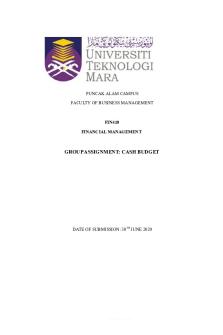The Cash Budget (Accounting) PDF

| Title | The Cash Budget (Accounting) |
|---|---|
| Author | Azad Qamar |
| Course | Interntnal Business |
| Institution | Nottingham Trent University |
| Pages | 2 |
| File Size | 56.2 KB |
| File Type | |
| Total Downloads | 113 |
| Total Views | 144 |
Summary
Download The Cash Budget (Accounting) PDF
Description
Accounting and Finance for International Managers:
The Cash Budget: Aims of a Business: -
Maximise shareholders wealth – long term. Manage risks (appropriate financial structure) – medium term. Maintaince adequate working capital and cash (liquidity) – short term.
Background to Cash Budget: What is a Budget? -
It is a plan to manage future business activities. Cash budget (cash flow forecast) involves predicting future cash inflows and outflows.
Why do Businesses Need Cash? -
Businesses must be ‘going concern’. A ‘going concern’ is a business that has a long-term future and can meet all its commitments. If a business cannot meet all its commitments, then it will become insolvent as known as ‘a gone concern’. Cash is needed to meet business commitments so without cash a business will fail.
Managing Cash: -
It is important that business have enough cash always of the year although, this will vary depending on the type of business. Businesses must not have too much cash because it will become wasteful. Cash doesn’t earn income.
Mechanics of Cash Budgets: -
Break period down into monthly columns. Identify cash receipts (cash inflows) according to the sources and total the receipt for each month. Identify cash payments (cash outflows) according to the purpose and the total of payments per month. Work out the net cash receipts/ cash payments of the months.
Cash Balance Calculations: Net Receipts/ Payments = Total Receipts – Total Payments Closing Balance = Opening Balance + Net Receipts/ Payments Cash Budgeting: Cash Sales: -
Amount of cash sales is entered in cash budget in month of sale.
Credit Sales:
Accounting and Finance for International Managers: -
From your knowledge of the business and from credit terms estimate the likely payment pattern of customers. Calculate what proportion of sales will be collected for each month following each sale. Estimate the level of bad debts and exclude these. Enter the expected income into the relevant months on the cash budget.
Implications of Cash Shortage: Inability to Meet Obligations: -
Loss of Reputation/ Bankruptcy
Need for Immediate Borrowing: -
Unplanned Overdraf Higher Cost of Borrowing Higher Cost Per Product Lower Profits Pressures to Increase Selling Price
Actions to Increase Cash: -
Delay capital expenditure on non-current assets.
-
Negotiate an overdraf facility/short term loan.
-
Collect debts from customers more quickly.
-
Cut expenses/overheads.
-
Sell non-current assets that are being under used.
-
Buying less inventory/stock – improve stock control.
-
Delay payment to suppliers.
Cash Budget Summary: -
Cash budgeting is an essential planning instrument for all organisations. Cash budgeting only deals with ‘receipts’ and ‘payments. Cash budgeting will identify the strengths and weaknesses of organisations. Cash budgeting enables decisions to be made to tackle future problems that are identified from a cash budget....
Similar Free PDFs

The Cash Budget (Accounting)
- 2 Pages

Cash Budget
- 1 Pages

Fin420 - Cash Budget
- 19 Pages

Cash Budget example
- 1 Pages

Forecasted CASH Budget Examples
- 3 Pages

Luton Pod Cash Budget Exercise
- 3 Pages

Assignment FIN420 cash budget 01
- 3 Pages

Accounting Budget Essay
- 2 Pages
Popular Institutions
- Tinajero National High School - Annex
- Politeknik Caltex Riau
- Yokohama City University
- SGT University
- University of Al-Qadisiyah
- Divine Word College of Vigan
- Techniek College Rotterdam
- Universidade de Santiago
- Universiti Teknologi MARA Cawangan Johor Kampus Pasir Gudang
- Poltekkes Kemenkes Yogyakarta
- Baguio City National High School
- Colegio san marcos
- preparatoria uno
- Centro de Bachillerato Tecnológico Industrial y de Servicios No. 107
- Dalian Maritime University
- Quang Trung Secondary School
- Colegio Tecnológico en Informática
- Corporación Regional de Educación Superior
- Grupo CEDVA
- Dar Al Uloom University
- Centro de Estudios Preuniversitarios de la Universidad Nacional de Ingeniería
- 上智大学
- Aakash International School, Nuna Majara
- San Felipe Neri Catholic School
- Kang Chiao International School - New Taipei City
- Misamis Occidental National High School
- Institución Educativa Escuela Normal Juan Ladrilleros
- Kolehiyo ng Pantukan
- Batanes State College
- Instituto Continental
- Sekolah Menengah Kejuruan Kesehatan Kaltara (Tarakan)
- Colegio de La Inmaculada Concepcion - Cebu







